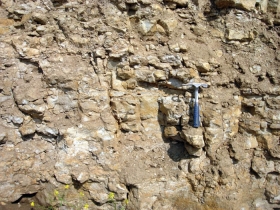Shale and Where it Lies

Shale oil is a rapidly developing source of oil and natural gas. Where does it lie? Estimated shale oil and shale gas resources in the United States and in 137 shale formations in 41 other countries represent 10% of the world's crude oil and 32% of the world's natural gas technically recoverable resources, or those that can be produced using current technology without reference to economic profitability, according to a new report released today by the U.S. Energy Information Administration (EIA). More than half of the identified shale oil resources outside the United States are concentrated in four countries--Russia, China, Argentina and Libya--while more than half of the non-U.S. shale gas resources are concentrated in five countries--China, Argentina, Algeria, Canada, and Mexico. The United States would be ranked second after Russia for shale oil resources and fourth after Algeria for shale gas resources if compared with the 41 countries assessed.
Oil shale, an organic-rich sedimentary rock, it does not have a definite geological definition nor a specific chemical formula, and its seams do not always have discrete boundaries. Oil shales vary considerably in their mineral content, chemical composition, age, type of kerogen, and depositional history and not all oil shales would necessarily be classified as shales in the strict sense.
Oil shale contains a lower percentage of organic matter than coal. In commercial grades of oil shale the ratio of organic matter to mineral matter lies approximately between 0.75:5 and 1.5:5. At the same time, the organic matter in oil shale has an atomic ratio of hydrogen to carbon (H/C) approximately 1.2 to 1.8 times lower than for crude oil and about 1.5 to 3 times higher than for coals. The organic components of oil shale derive from a variety of organisms, such as the remains of algae, spores, pollen, plant cuticles and corky fragments of herbaceous and woody plants, and cellular debris from other aquatic and land plants.
Technically Recoverable Shale Oil and Shale Gas Resources: An Assessment of 137 Shale Formations in 41 Countries Outside the United States estimates that shale resources taken in conjunction with EIA's own assessment of resources within the United States indicate technically recoverable resources of 345 billion barrels of world shale oil resources and 7,299 trillion cubic feet of world shale gas resources. While the current report considers more shale formations than were assessed in a previous version, it still does not assess many prospective shale formations, such as those underlying the large oil fields located in the Middle East and the Caspian region. Currently, only the United States and Canada are producing shale oil and shale gas in commercial quantities.
EIA commissioned Advanced Resources International, Inc. (ARI) to conduct the new world shale resource assessment because shale oil production has become a significant source of oil supply within the United States and because more and better geologic information has become available for shale formations located outside the United States. An earlier EIA/ARI study from 2011 stimulated new work on shales in many countries (e.g., Algeria, Argentina, and Mexico), providing significantly more data for the 2013 study.
"As shale oil and shale gas production has grown in the United States to become 30% of oil and 40% of natural gas total production, interest in the oil and natural gas resource potential of shale formations outside the United States has grown," said EIA Administrator Adam Sieminski. "Today's report indicates a significant potential for international shale oil and shale gas, though the extent to which technically recoverable shale resources will prove to be economically recoverable is not yet clear."
Shale oil and shale gas resource estimates are highly uncertain and will remain so until the shale basins are extensively tested with production wells. This report's methodology for estimating the shale resources outside the United States is based on the geology and resource recovery rates of similar shale formations in the United States that have produced shale oil and shale gas from thousands of producing wells.
For further information see EIA Report.
Shale image via Wikipedia.
©2013. Copyright Environmental News Network To subscribe or visit go to: http://www.enn.com